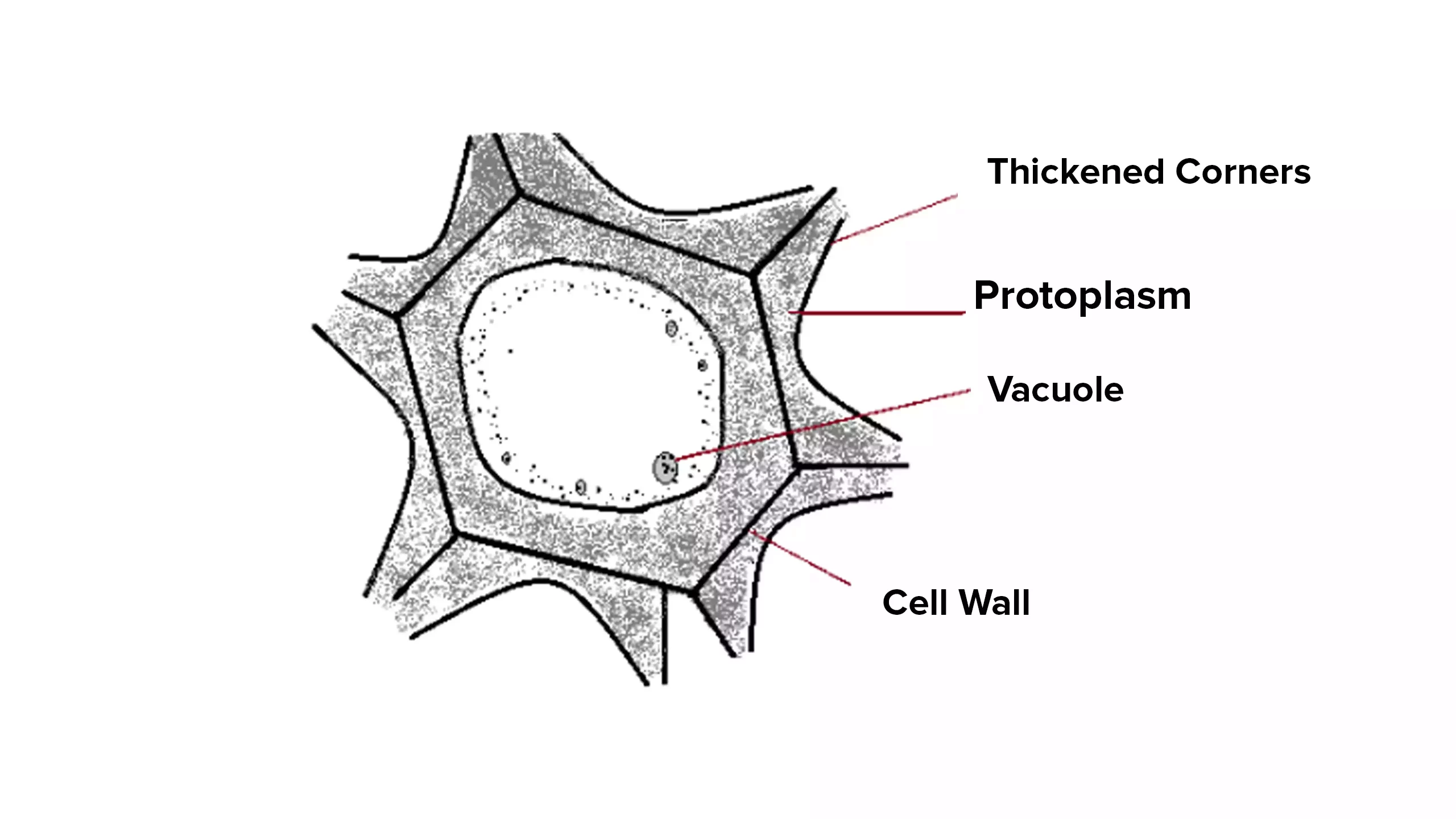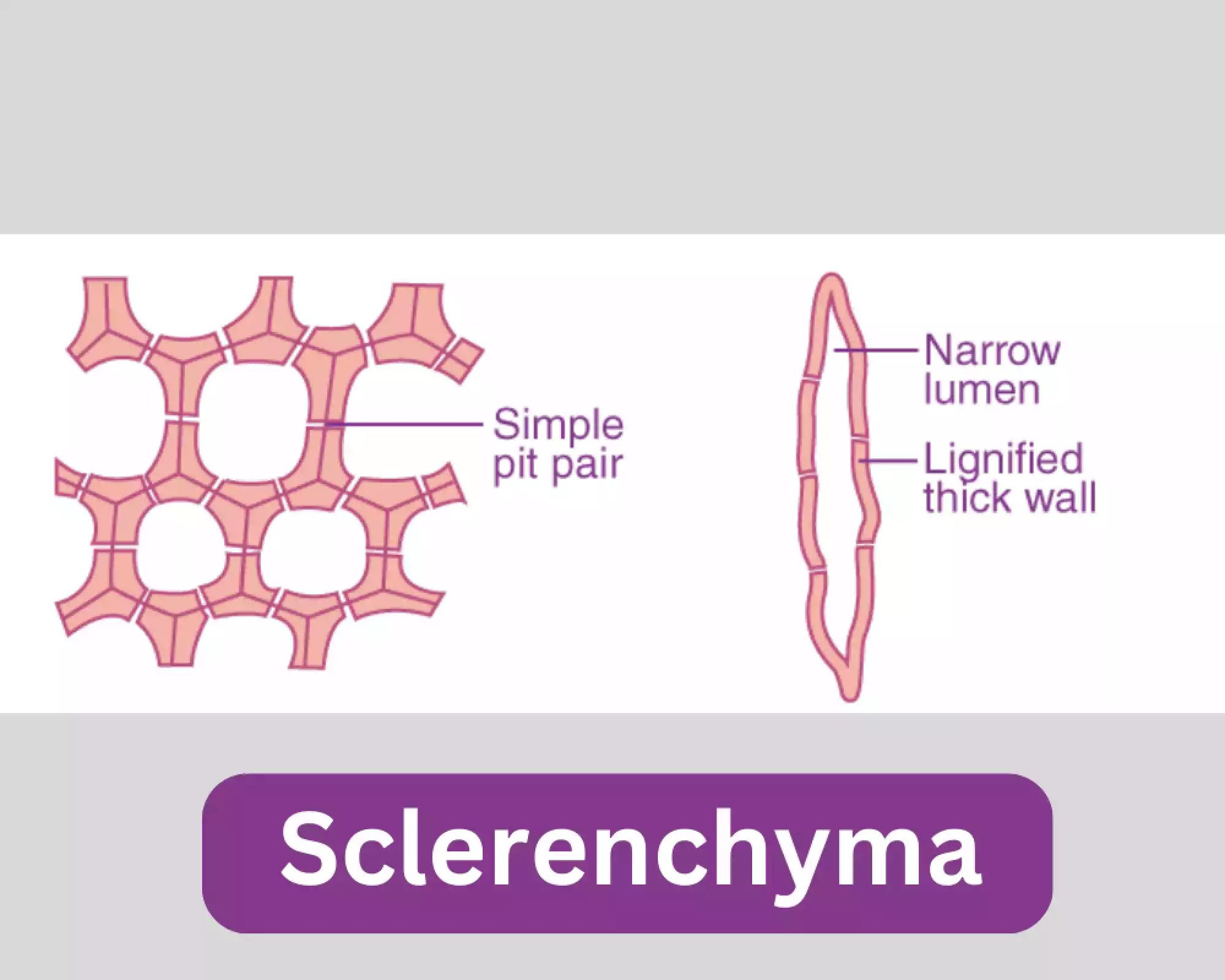Collenchyma and Sclerenchyma
Collenchyma and sclerenchyma are two types of plant tissues that serve important structural functions. Collenchyma cells are living cells with irregularly thickened primary cell walls. They are found in regions of active growth and provide flexibility and support during plant development. Collenchyma cells have primary cell walls composed of cellulose, hemicellulose, and pectin.
On the other hand, sclerenchyma cells are dead cells with heavily lignified secondary cell walls. They are distributed throughout mature plant tissues, providing rigidity and mechanical strength. Sclerenchyma cells have secondary cell walls containing lignin, which increases their durability and hardness.
While collenchyma aids in the flexible support of growing plant parts, sclerenchyma provides rigid support and protection to mature plant organs. Examples of plant structures containing collenchyma include petioles and leaf veins, while sclerenchyma can be found in seed coats, nutshells, and vascular bundles. Understanding the differences between collenchyma and sclerenchyma helps us appreciate their distinct roles in plant growth and structure.
What is the importance of Collenchyma and Sclerenchyma cells?
Sclerenchyma and Collenchyma cell types are vital to plant development, growth, as well as structural integrity. In this article, we will discuss the significance of the two cell types:
Collenchyma:
- Help during growth: Collenchyma cells provide mechanical help to the growing organs in plants like petioles and stems as well as leaf midribs. They aid in maintaining their form and stand up to the strains of mechanical forces.
- Flexibleness and plasticity: Collenchyma cells are flexible and provide plasticity to the growing parts of plants. They are able to bend and stretch without breaking. They also accommodate the expansion and movement that occurs in the growth of plants.
- Structural Reinforcement: Collenchyma tissue is a strong and durable reinforcement of organs of the plant, thereby providing assistance to the areas that are experiencing active growth. This type of reinforcement is crucial in herbaceous plants because the stem’s rigidity is low when compared with trees.
Sclerenchyma:
- Mechanical Support: Sclerenchyma cells offer structural strength and help to mature plant organs like roots, stems, and seed coats. They are rigid and highly lignified. secondary cell walls are essential to the structural stability of the organs.
- Protective: Sclerenchyma cells also contribute in protecting plants’ structures. As an example, when it comes to the seed coat and in nutshells the strength and durability provided by sclerenchyma cell help protect the seedlings in development.
- Longevity and durability: Sclerenchyma cells are dead when they reach maturity. The thickly lignified cell walls provide them with a long-lasting and durable structure that is resistant to degeneration. They are able to last for a long time, which ensures the strength and integrity of the tissue of plants.
Both sclerenchyma and collenchyma tissues form a crucial part of the plant’s structural framework. They provide the necessary support and durability to various organs in different phases of development. The presence of these tissues and their specialized properties help plants withstand external pressures, keep their structure, and guard crucial structures throughout their lifespan cycle.
Meaning of Collenchyma
Collenchyma is a form of plant tissue made up of living cells, with thin and irregularly thickened wall cells. It’s found mostly in areas of growing activity like the petioles and stems of the young plant. Collenchyma cells possess an elastic and flexible shape that provides the necessary support and durability to part of the plant.
The cell wall of the primary collenchyma cell walls is made up of hemicellulose, cellulose, and pectin. The walls of collenchyma cells are thickened unevenly and often form an elongated patch or strands. This thickening gives structure support, while also providing some elasticity to the plant’s growth and growth.

The Collenchyma tissue plays a variety of roles in the plant. It is a source of mechanical support for organs that are developing and still in their embryonic stages and helps them resist the effects of mechanical stress and keep their form. Collenchyma cells also aid in the elasticity of plant components that allow for bends and turning without breaking.
The most common plant structures that have collenchyma comprise the outer layer of stems with herbaceous leaves, leaf midribs, and the edges of certain leaf cells. They are often in need of protection during growth and collenchyma offers the required durability and flexibility.
The Collenchyma Tissue plays an essential part in the growth of plants and development, providing structure and support for developing organs in the plant.
Meaning of Sclerenchyma
Sclerenchyma is one of the types of plant tissue that is composed of cells that have died and are surrounded by heavily lined secondary wall cells. It can be seen in many maturing organs of plants, including stems, roots, and seed coats. The cells of the sclerenchyma are extremely designed to offer mechanical protection and support for plant structures.
The cell walls that are secondary to the sclerenchyma cell contain a significant concentration of lignin. It gives them a rigid, long-lasting, and impervious to decay. Lignification is the process that involves the creation of lignin which is an intricate polymer, into cells’ walls. It provides strength and toughness.

There are two kinds of sclerenchyma cells: fibers and sclereids. Fiber cells are large and slim, usually found in bundles. They offer strength and help for plant tissue. Sclereids are on the other on the other hand, are smaller and more slender cells that contribute to protecting plant organs through the formation of tough shells, or layers.
Sclerenchyma tissue is the plant’s structural framework that strengthens the body of the plant as well as provides support to the plant body against external force. It provides strength to the stems of plants, which allows the stems to resist bending and breaking. Sclerenchyma cells contribute to the strength of nuts, seed coats, and shells on fruit.
The Sclerenchyma tissues play a vital part in the maturing plants, providing strength as well as durability and security. Cells, which have highly lignified, secondary walls help to strengthen and durability of organs in plants and aid in the growth of plants in a variety of environments.
Characteristics of Collenchyma
Collenchyma cell characteristics are:
- Cell Shape and Arrangement: Collenchyma cells have an elongated form, usually with ends that taper. They may be placed as strands or in patches creating continuous or discontinuous layers in plants’ tissues.
- Primary Cell Walls: Collenchyma cells possess primary cell walls which differ in thickness. The bulking tends to be located around the edges of cells, or on the walls of cells. The uneven thickening adds assistance and strengthens cells.
- cell wall composition: the main wall cells of collenchyma cells comprise cellulose, Pectin, hemicellulose, as well as a few other components. These elements are responsible for the flexibility and tensile force of the cell wall.
- Living cells: Collenchyma cells are living cells, different from sclerenchyma cells which die at the age of maturation. Living characteristics allow the collenchyma cell to go through metabolic processes and react to signals of growth and development.
- The locations: Collenchyma tissue is commonly located in areas where plants are experiencing active growth like petioles, stems and midribs on leaf leaves, and in the edges of leaf cells.
- Flexible Support: Collenchyma cells offer flexibility to plants and plant components. They are strong and robust for enduring mechanical strains, they provide a degree of stretching and flexibility in the growth.
- Plastids: Collenchyma cells typically contain large quantities of plastids. These play a role in the production and storage of a variety of chemicals, such as pigments, oils, starch and other substances.
- Parenchymatous Nature: Collenchyma cells have a parenchymatous nature that is, they contain live protoplasts, which have functioning nuclei as well as other organelles.
The combination of these features contributes to the distinctive characteristics and function of the collenchyma tissues, such as the ability of it to offer flexibility to organs in plants, and also keep the structural integrity of their structure.
Characteristics of Sclerenchyma
The characteristics of sclerenchyma cells include:
- Cell Shape and Arrangement: Sclerenchyma cells are elongated in shape, similar to collenchyma cells. They can occur as individual cells or in bundles, forming long fibers, or as irregularly shaped cells called sclereids.
- Secondary Cell Walls: Sclerenchyma cells have heavily lignified secondary cell walls. These walls are uniformly thickened throughout the cell and provide rigidity, hardness, and strength to the cells.
- Cell Wall Composition: The secondary cell walls of sclerenchyma cells are composed of cellulose, hemicellulose, and a significant proportion of lignin. Lignin is a complex polymer that gives the cell walls their characteristic rigidity and resistance to decay.
- Dead Cells: Unlike collenchyma cells, sclerenchyma cells are dead at maturity. Once fully developed, their protoplasts disintegrate, leaving behind only the lignified cell walls.
- Locations: Sclerenchyma tissue is distributed throughout mature plant organs. It can be found in the stems, roots, leaf veins, seed coats, nutshells, and the shells of fruits such as coconuts.
- Mechanical Support and Protection: Sclerenchyma cells provide mechanical support and protection to plant organs. Their rigid and lignified cell walls lend strength and structural integrity, allowing plants to withstand mechanical stresses and maintain their shape. Sclerenchyma cells also offer protection to delicate structures like seeds by forming hard seed coats and nutshells.
- Longevity and Durability: Sclerenchyma cells have a long lifespan due to their dead nature. The lignified secondary cell walls make them highly durable and resistant to degradation.
- Lack of Plasmodesmata: Sclerenchyma cells lack plasmodesmata, which are small channels that allow for communication and transport between adjacent plant cells. The absence of plasmodesmata contributes to the non-living and non-metabolically active nature of sclerenchyma cells.
These characteristics collectively define the unique properties and functions of sclerenchyma tissue, which include providing mechanical strength, protection, and longevity to mature plant organs.
Differences between Collenchyma and Sclerenchyma
Cell Structure and Arrangement:
- Collenchyma: consists of living cells, with thin and irregularly thickened primary cells. The thickening tends to be located around the edges or on the cell wall.
- Sclerenchyma: consists of dead cells that have highly lignified cell walls of the secondary cells. The secondary wall is uniformly thickened, and typically contain a tough and rigid surface.
Flexibility and Elasticity
- Collenchyma: Offers flexible and supportive expansion and also allows for stretching and bending without breaking.
- Sclerenchyma: Provides stiffness and strength through the cell walls that are heavily lignified offering protection and support but isn’t flexible.
Placement within Organs of the Plant:
- Collenchyma: Collenchyma It is seen in the areas that are growing like the petioles and stems and midribs on the leaf of new plants.
- Sclerenchyma: Found all over mature plant tissues which include roots, stems as well as seed coats. the outer shells of fruit.
Composition of Cell Walls:
- Collenchyma: The primary cell wall consisting of cellulose, hemicellulose, and pectin. They have various levels of thickness.
- Sclerenchyma:The walls of the secondary cells are enriched with the lignin protein, which gives rigidity and abrasion to cells.
The role and function:
- Collenchyma: Collenchyma provides support throughout the process of growth and development. It provides the flexibility needed to grow the organs of plants and assists them to maintain their appearance.
- Sclerenchyma: Provides the structural strength and protects older organs of the plant, and provides the strength and rigidity to endure the rigors of mechanical stress. Some examples of plant structures that have collenchyma are the outer layer of stems that are herbaceous and the leaf cell edges. Sclerenchyma may be observed in seeds, nutshells, and the outer shells of fruits like coconuts and fibrous tissue in plant tissues such as flax and hemp.
The understanding of these differences allows us to differentiate the role and impact of collenchyma as well as sclerenchyma for plant development, growth as well as structural integrity.
The similarity between Collenchyma and Sclerenchyma
The collenchyma, as well as the sclerenchyma tissues, are different types of plant tissues that have a variety of distinctions, they also share certain similarities.
These are some similarities:
1. Collenchyma Cell Wall Composition: As well as sclerenchyma cells possess cells that have walls that give the structural structure to the plant tissue.
- Collenchyma: The cell wall of collenchyma cells contains hemicellulose and cellulose as well as pectin.
- Sclerenchyma: Secondary cells of sclerenchyma consist of cellulose hemicellulose, as well as lignin.
2. Mechanical Support: The two tissues are both responsible for the strength and strength of the plant structure.
- Collenchyma: Collenchyma cells provide help throughout the development and growth of organs that are young in the plant and allow them to endure mechanical strains.
- Sclerenchyma: Sclerenchyma cells offer structural strength and protect older organs of the plant, strengthening their rigidity as well as providing strength and mechanical support.
3. The types of plant tissue: Collenchyma and sclerenchyma both are kinds of ground tissues found within plants.
- Ground Tissue: These tissues have a number of roles such as storage, support as well as photosynthesis. Collenchyma and sclerenchyma, respectively, are the specialized types of ground tissue that offer structural structure.
4. The cell type: Collenchyma cells and the sclerenchyma cell are both elongated in form.
- Collenchyma: Collenchyma cells have a shape that is elongated and may be clustered in strands or patches.
- Sclerenchyma: Sclerenchyma cells are additionally elongated, usually forming large fibers or irregularly formed Sclerreids.
There are many similarities between sclerenchyma, collenchyma, and collenchyma but it is crucial to remember the distinctions in their cell wall composition cells, structure, mobility, and position within organs of plants distinguish their roles and functions in the plant tissue.
Summary
Collenchyma and sclerenchyma are the two kinds of ground tissues. Collenchyma cells have elongated subepidermal cells, with thickening irregularly on wall cells. They are the primary supporting cells and contain thicker secondary wall cells. Collenchyma cell walls are composed of pectin and cellulose while the walls of sclerenchyma cell cells include hemicelluloses, celluloses and lignin.
Collenchyma cells are alive, whereas those of sclerenchyma are dead cells. Collenchymas cells have the nucleus and cytoplasm and sclerenchyma cells don’t. So, that’s the distinction between collenchymas as well as sclerenchyma.

